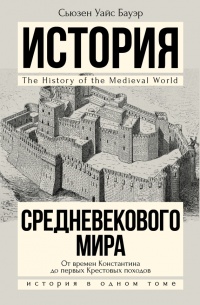Читать книгу "История Древнего мира. От истоков цивилизации до падения Рима - Сьюзен Уайс Бауэр"
Шрифт:
Интервал:
Закладка:
7. Clayton, p. 60.
8. A. Rosalie David, The Egyptian Kingdoms (1988), p. 16.
9. Абзац 217 дан в переводе из: J. H. Breasted in Development of Religion and Thought in Ancient Egypt (University of Chicago Press, 1912); далее абзац 309 взят в переводе: R. O. Faulkner in The Ancient Pyramid Texts (Clarendon Press, 1969); оба процитированы: Jon E. Lewis, ed., Ancient Egypt (2003), pp. 27–29.
10. Clayton, p. 64.
11. Quoted in Clayton, p. 67.
12. Colin McEvedy, The New Penguin Atlas of Ancient History (2002), p. 36.
ГЛАВА ШЕСТНАДЦАТАЯ. ПЕРВЫЕ ВТОРЖЕНИЯ ВАРВАРОВ
1. Kramer, The Sumerians, p. 61.
2. Roaf, p. 98.
3. Впервые отмечено: Hugo Radau, Early Babylonian History Down to the End of the Fourth Dynasty of Ur (1899), p. 307.
4. David Willis McCullough, ed., Chronicles of the Barbarians (1998), p. 8.
5. Oppenheim, Ancient Mesopotamia, p. 62.
6. «The Cursing of Agade», in ETC.
7. Ibid.
8. Kramer, The Sumerians, p. 330.
9. «A tigi to Bau for Gudea», in ETC.
10. «The Victory of Utu-hegal», in ETC.
11. Kramer, The Sumerians, p. 325.
12. «Ur-Namma the canal-digger», in ETC.
13. «A praise poem of Ur-Namma» in ETC.
ГЛАВА СЕМНАДЦАТАЯ. ПЕРВЫЙ ПРИВЕРЖЕНЕЦ МОНОТЕИЗМА
1. Gen. 10:11–24.
2. Victor P. Hamilton, The Book of Genesis: Chapters 1–17 (1990), p. 363.
3. Adapted from «The death of Ur-Namma (Ur-Namma A)», in ETC.
4. Jonathan N. Tubb, Canaanites: Peoples of the Past (1998), p. 15.
5. J. M. Roberts, p. 41.
6. Tubb, p. 39.
7. Donald B. Redford Egypt, Canaan, and Israel in Ancient Times (1992), pp. 63–64.
8. Aidan Dodson and Dyan Hilton, The Complete Royal Families of Ancient Egypt (2004), p. 80.
9. Quoted in Redford, Egypt, pp. 67–68.
10. Qur’an 2.144–150.
11. Roaf, p. 101.
12. Quoted in Leick, Mesopotamia, pp. 132–133.
13. Leick, Mesopotamia, p. 126.
14. Roaf, p. 102.
15. Tubb, p. 38.
ГЛАВА ВОСЕМНАДЦАТАЯ. ПЕРВОЕ НЕСЧАСТЬЕ В СРЕДЕ ОБИТАНИЯ
1. John Perlin, Forest Journey: The Role of Wood in the Development of Civilization (1991), p. 43.
2. Thorkild Jacobsen, Salinity and Irrigation Agriculture in Antiquity (1982), p. 468.
3. D. Bruce Dickson, «Circumscription by Anthropogenic Environmental Destruction: An Expansion of Carneiro’s (1970) Theory of the Origin of the State», American Antiquity 52:4 (1987), p. 713.
4. Kramer, The Sumerians, pp. 333–334, adapted.
5. Ibid., pp. 334–335, adapted.
6. Несколько адаптировано из: «The Lament for Urim», in ETC.
7. Ibid.
ГЛАВА ДЕВЯТНАДЦАТАЯ. БИТВА ЗА ОБЪЕДИНЕНИЕ
1. Verbrugghe and Wickersham, p. 137.
2. Stephan Seidlmayer, «The First Intermediate Period», in The Oxford History of Ancient Egypt, ed. Ian Shaw (2002), pp. 128–129.
3. Verbrugghe and Wickersham, p. 194.
4. Clayton, p. 72.
5. «Instructions for Merikare», in Miriam Lichtheim, Ancient Egyptian Literature, vol. 1 (1975), p. 70.
6. Shaw, p. 161.
7. Ibid., p. 151.
8. Dodson and Hilton, p. 87.
9. Ibid., p. 90.
10. «The Prophecy of Nerferti», quoted in Shaw, p. 158.
11. Clayton, p. 79.
12. Shaw, p. 160.
13. Silverman, p. 79.
ГЛАВА ДВАДЦАТАЯ. МЕСОПОТАМСКИЙ КОТЕЛ
1. Reconstruction of «Ishbi-Erra and Kindattu», segments A, B, D, and E in ETC.
2. Roaf, p. no.
3. Saggs, Assyria, pp. 28–30.
4. Reconstructed from the somewhat fragmented «Letter from Nann-ki-ag to Lipit-Estar about Gungunum’s troops» and «Letter from Lipit-Estar to Nann-ki-ag about driving away the enemy», both in ETC.
5. «An adab to Nanna for Gungunum (Gungunum A)», in ETC.
6. L. W. King, The Letters and Inscriptions of Hammurabi, vol. 3 (1976), p. 213, translation of «Reign of Sumuabu».
7. Translated by A. K. Grayson, Assyrian and Babylonian Chronicles (1975), p. 155.
8. Assyrian king list quoted in Saggs, Assyria, p. 25.
9. Daniel David Luckenbill, Ancient Records of Assyria and Babylon, Volume I: Historical Records of Assyria from the Earliest Times to Sargon (1926), p. 16.
10. Saggs, Assyria, p. 37. n. Roaf, p. 116.
12. Saggs, Assyria, p. 25.
13. Gwendolyn Leick, The Babylonians: An Introduction (2003), p. 33.
14. Oppenheim, Ancient Mesopotamia, p. 156.
15. H. W. F. Saggs, Babylonians (1995), p. 98.
ГЛАВА ДВАДЦАТЬ ПЕРВАЯ. ПАДЕНИЕ СЯ
1. Ssuma Ch’ien, The Grand Scribe’s Records, vol. 1, ed. William H. Nienhauser, Jr., translated by Tsai-fa Cheng et al. (1994), p. 21.
2. Ibid., p. 22.
3. Ibid., p. 32.
4. John King Fairbank and Merle Goldman, China: A New History (2002), p. 37.
5. Li Liu and Xingcan Chen, State Formation in Early China (2003), p. 35.
6. Ibid., p. 35.
7. Ch’ien, p. 37.
8. Ibid., p. 38.
9. J. A. G. Roberts, p. 5.
10. Ch’ien, p. 38; the exact quote is «I regret failing to kill T’ang in Hsia-t’ai; that is what has brought me to this».
ГЛАВА ДВАДЦАТЬ ВТОРАЯ. ИМПЕРИЯ ХАММУРАПИ
1. Jorgen Laessoe, People of Ancient Assyria: Their Inscriptions and Correspondence (1963), p. 47.
2. Перефразировано для лучшего понимания из: Laessoe, p. 50.
3. Laessoe, pp. 68–69.
4. Ibid., p. 76.
5. Ibid., p. 78.
6. Реконструкция Андре Парро из надписей Мари, приведено в: Jack M. Sasson, «The King and I: A Mari King in Changing Perceptions», Journal of the American Oriental Society 118:4 (1998), p. 454.
Внимание!
Сайт сохраняет куки вашего браузера. Вы сможете в любой момент сделать закладку и продолжить прочтение книги «История Древнего мира. От истоков цивилизации до падения Рима - Сьюзен Уайс Бауэр», после закрытия браузера.




